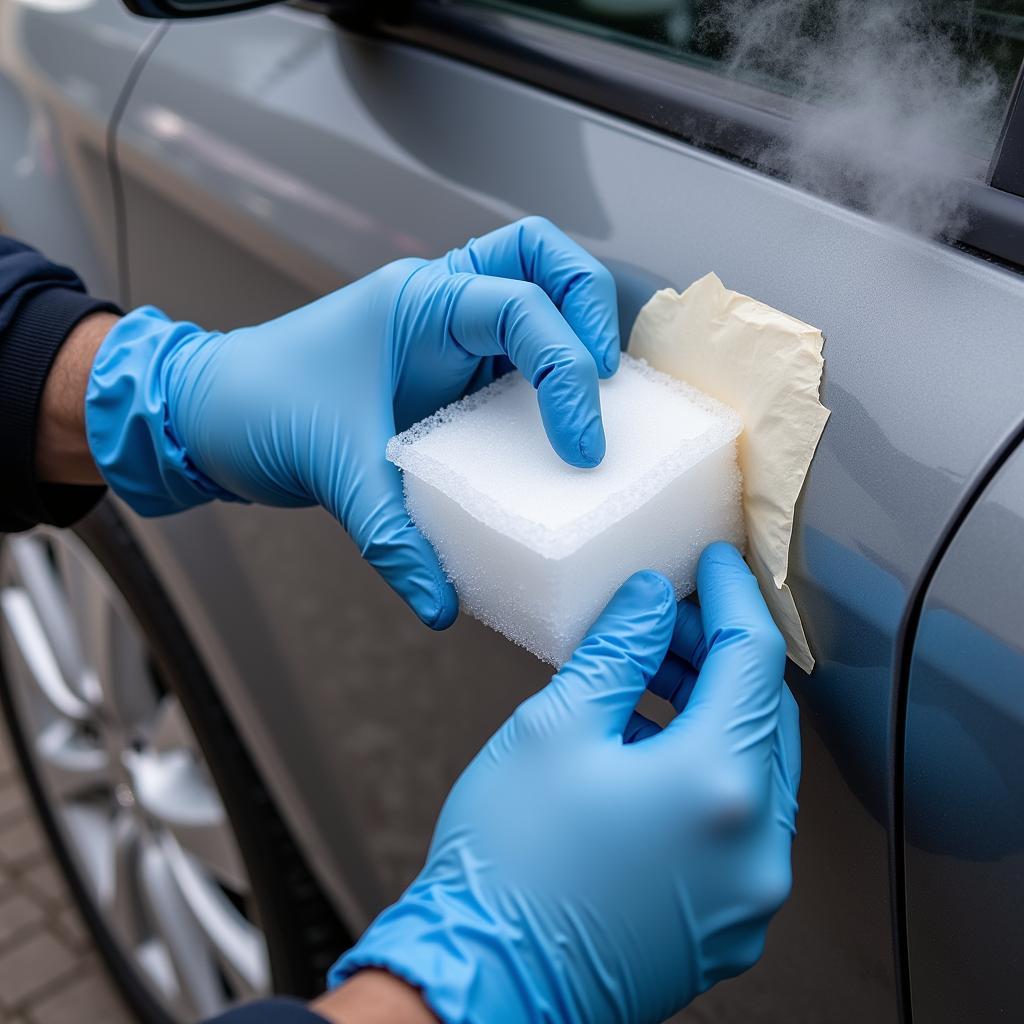Does Dry Ice Fix Car Dents? It’s a question that pops up frequently online, sparking curiosity and DIY aspirations. While the idea of magically removing dents with dry ice sounds appealing, the reality is a bit more nuanced. Let’s delve into the science behind this popular method and explore its effectiveness, safety precautions, and alternatives. how to fix rust dent on car
Understanding the Dry Ice Dent Removal Method
Dry ice, the solid form of carbon dioxide, reaches an extremely low temperature of -78.5 degrees Celsius (-109.3 degrees Fahrenheit). When applied to a dented metal surface, the rapid temperature change can cause the metal to contract and potentially pop the dent back out. This method primarily targets small, shallow dents, particularly those on flexible panels like car doors or fenders. However, it’s not a guaranteed fix for all dents, and improper application can worsen the damage.
 Applying Dry Ice to a Car Dent
Applying Dry Ice to a Car Dent
Does Dry Ice Work on All Types of Dents?
Unfortunately, dry ice isn’t a universal solution for every dent. Deep dents, creases, or dents on structural components are unlikely to respond to this method. The success rate depends on several factors, including the size and depth of the dent, the type of metal, and the overall condition of the car’s paint. For significant damage, professional dent repair remains the best option.
How to Use Dry Ice for Dent Removal (Safely)
If you’re considering trying the dry ice method, prioritizing safety is crucial. Always wear thick, insulated gloves to prevent frostbite. Ensure adequate ventilation to avoid inhaling excessive CO2. Here’s a step-by-step guide:
- Clean the dented area: Remove any dirt or debris.
- Protect surrounding areas: Use masking tape and/or a protective covering.
- Wear protective gear: Thick gloves are a must.
- Apply the dry ice: Hold the dry ice with gloved hands and rub it gently over the dent in a circular motion.
- Observe: Watch for the dent to pop out. This may require several applications.
- Allow the area to return to room temperature: Avoid touching the metal immediately after application.
Remember, fixing a dent in car often requires professional expertise. While dry ice might work for minor dents, seeking professional help ensures proper repair and prevents further damage. Don’t hesitate to reach out to a qualified technician for an assessment.
Alternatives to Dry Ice Dent Removal
Several other DIY dent removal methods exist, including using a plunger, hot glue, or a hair dryer. You can even try hair fixing cars, though it might sound peculiar! Professional techniques like paintless dent repair (PDR) offer more reliable results for more severe dents. car small scratch fix can also be done with various techniques.
“Dry ice can sometimes work for minor dents, but it’s not a miracle cure,” says John Smith, an Automotive Engineer at Autotippro. “Understanding the limitations and potential risks is crucial before attempting this method.” Another expert, Sarah Jones, a Senior Technician with over 20 years of experience adds, “Safety always comes first. If you’re unsure, consult a professional.”
When to Call a Professional
While DIY solutions can be tempting, knowing when to call a professional is important. If the dent is large, deep, or located on a complex panel, professional dent repair is often the best course of action. Attempting DIY repairs on significant damage can sometimes exacerbate the problem. Don’t hesitate to seek professional advice. You can contact us, Autotippro, at +1 (641) 206-8880 or visit our office at 500 N St Mary’s St, San Antonio, TX 78205, United States.
Does dry ice remove dents permanently?
While dry ice can sometimes pop out small dents, the results aren’t always permanent. The dent might reappear over time, especially if exposed to temperature fluctuations.
Can I use dry ice on aluminum car panels?
Yes, you can use dry ice on aluminum panels, but extra caution is required. Aluminum is more sensitive to temperature changes, so apply the dry ice briefly and carefully. how to fix braeking car upper panel might require other techniques.
Is dry ice dent removal expensive?
Dry ice itself is relatively inexpensive. However, if the DIY method fails, professional repair costs can vary depending on the dent’s severity.
What are the risks of using dry ice on car paint?
Improper application of dry ice can damage the car’s paint, causing cracking or discoloration. Always protect the surrounding area and apply the dry ice carefully.
Can dry ice crack car windows?
While unlikely, applying dry ice directly to a car window can potentially cause thermal stress and cracking. Avoid contact with glass surfaces.
Is there a better alternative to dry ice for dent removal?
Professional paintless dent repair (PDR) is generally considered a more reliable and effective method for removing dents, especially those that are larger or more complex.
In conclusion, while dry ice can sometimes fix car dents, particularly small and shallow ones, it’s not a foolproof solution. Understanding the limitations, prioritizing safety, and knowing when to consult a professional are key to successful dent repair. Does dry ice fix car dents? Sometimes, but it’s essential to approach this method with caution and realistic expectations. For any questions or assistance, connect with us at AutoTipPro at +1 (641) 206-8880. We’re located at 500 N St Mary’s St, San Antonio, TX 78205, United States, and are always happy to help.





Leave a Reply